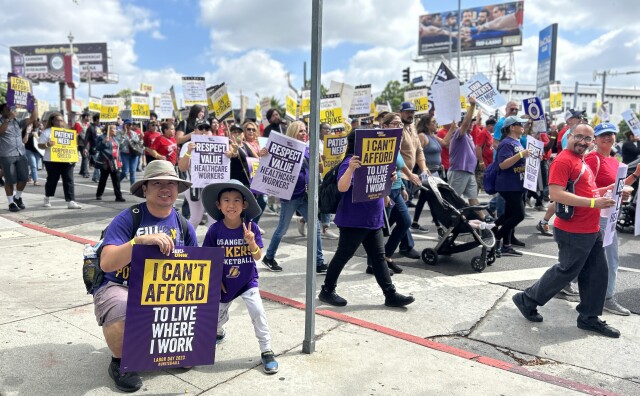Latino Political Power Is Stronger Than Ever In California (And Young Voters Have Played A Big Role)

Recent projections out of USC show that Latinos will account for 21.5% of all voters casting a ballot this March -- that's around 1.9 million people, according to Mindy Romero, director of USC's California Civic Engagement Project.
"[It's] the largest number that we've seen since we've been tracking data on the Latino vote," she says.
Romero crunched the numbers based on 2016 primary turnout and the state's total population, which shows that many young Latinos will be eligible to vote for the first time.
Latino voting power could have national implications; it's enough to sway political fortunes in six of California's congressional districts.
In some places, it already has: During the 2018 midterm, Latinos in the 21st District in Central California cast almost half the votes there and played a big part in flipping it blue. It was a tight contest, but Democrat T.J. Cox eked out enough votes to unseat longtime GOP incumbent David Valadao.
Still, Latino voter turnout continues to be among the lowest in the state, for complicated reasons that range from being overlooked by political parties to the relative youth of the Latino population. That's something outreach organizations hope to fix.
"Candidates, campaigns, parties haven't historically focused on people of color as a majority group, even though now they make up not only the majority of the state, but in terms of the Latinx voters, they make up the plurality of anyone now under the age of 34," says Luis Sanchez, executive director of Power California.
His organization is part of a broader effort to energize Latino voters across the state. Together, they hope to reach more than 500,000 eligible voters by the March 3 primary.

Reaching those young Latinos presents a unique challenge. For many, voting isn't a tradition at home. Some grew up with non-citizen parents. Some in the past have reported being too busy to vote, or feeling like their vote won't count.
Another challenge that get-out-the-vote efforts face: convincing political campaigns to look past stereotypes. Campaigns that just show up in Latino communities right before elections don't see positive turnout, perpetuating a belief that communities of color are more apathetic. Sanchez says that's not true.
"What we've learned is that you can't just engage young people, you can't just engage Latinx voters in that election cycle," he says. "You have to build that confidence, you have to build that buy-in way before."
That buy-in begins, he says, when people know what's at stake. Immigration, the environment, and schools are among the top issues among Latino voters this year.
Sanchez says the rest of the buy-in comes by staying in touch with voters. To that end, organizations like his are deploying a wide-reaching digital strategy aimed at meeting young voters where they are, and even telling them how to cast their ballots.
"Especially this year, when we're actually implementing new voting systems in maybe the largest [most populated] counties across the state," Sanchez says. "I think the onus is on us to figure out how best to educate them so when it comes for them to vote, they feel comfortable voting."
-
After San Gabriel's city council rejected the proposal as "too narrow", one city councilmember argued the entire DEI commission, created in the aftermath of George Floyd's murder, had "run its course."
-
A medical industry challenge to a $25 minimum wage ordinance in one Southern California city suggests health workers statewide could face layoffs and reductions in hours and benefits under a state law set to begin phasing in in June. Some experts are skeptical, however, that it will have such effects.
-
Sandhill cranes are returning to the Lake Tahoe basin after a century long hiatus in what many say is a conservation success story.
-
The Dodgers fired Mizuhara in March after Ohtani's lawyers accused him of stealing millions of dollars from the baseball player to place bets with an Orange County-based bookie.
-
Jackie’s partner, Shadow, refuses to abandon their unviable eggs, despite her attempts to nudge him along.
-
Big Sur's Highway 1 was built to maximize the breathtaking views of the cliffs and ocean at the cost of the road's longterm stability.






